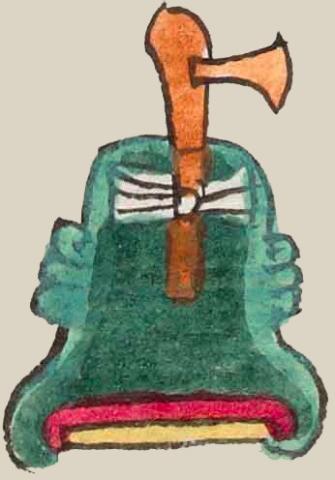Tepoztlan (Mdz24v)
This compound glyph for the place name Tepoztlan shows a hill or mountain in two tones of green with the yellow and red horizontal stripes at its base. On the hill is a vertical hatchet with a wooden handle (terracotta in color), a white bow tie (of cloth or paper, unclear), and an embedded, triangular blade that is golden/reddish in color (likely copper), the same terracotta color but lighter. The hatchet has a curved blade. While the hatchet almost provides a simplex for the reading Tepoztlan, the locative -tlan could be seen as represented by the hill or mountain. Hence, we are considering this a compound glyph.
Stephanie Wood
The white bow or tie may have been used to attach the axe to the throne (icpalli) of the lord who owned it, if the examples from the Codex Veinte Mazorcas are any indication. In that manuscript, one nobleman holds his axe, while the other has his axe in a holder tied to the back of his royal seat. In this glyph for Tepoztlan, the locative suffix -tlan is not presented visually, but the tepetl, which does not figure phonetically in the name provides a kind of silent locative (and what Gordon Whittaker would call a "semantic complement"). Further, the modern town of Tepoztlan is right next to a sacred mountain.
Stephanie Wood
tepuztlā. puo
Tepotztlan, pueblo (modern Tepoztlan)
Stephanie Wood
c. 1541, or by 1553 at the latest
Stephanie Wood
copper, axes, hatchets, hills, mountains, cerros, montañas, hachas, cobre, -tlan locative, nombres de lugares

tepoz(tli), copper, metal; axe, https://nahuatl.wired-humanities.org/content/tepoztli
-tlan (locative suffix), https://nahuatl.wired-humanities.org/content/tlan
Codex Mendoza, folio 24 verso, https://digital.bodleian.ox.ac.uk/objects/2fea788e-2aa2-4f08-b6d9-648c00..., image 59 of 188.
The Bodleian Libraries, University of Oxford, hold the original manuscript, the MS. Arch. Selden. A. 1. This image is published here under the UK Creative Commons, “Attribution-NonCommercial-ShareAlike 3.0 License” (CC-BY-NC-SA 3.0).


